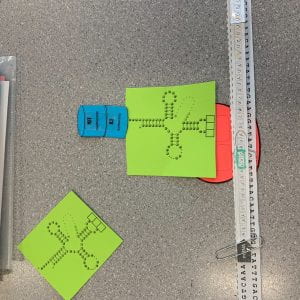RNA Transcription Model
- How is mRNA different than DNA?
- Describe the process of transcription.
- How did today’s activity do a good job of modelling the process of RNA transcription? In what ways was our model inaccurate?
- RNA is a polynucleotide like DNA, but they are different in 3 ways with DNA. They are single stranded and short and contains sugar ribose. Also, they use base Uracil instead of Thymine. Also, DNA can be over 85 million base pairs long, but mRNA is usually 1000. Transcription is the process by which the information on 1 DNA gene is copied onto a strand of mRNA. Basically, one gene on DNA translate into mRNA. A specific part of DNA unwinds, exposing one gene. Along 1 strand of DNA which is called “sense” strand, complementary RNA bases are brought in. For example, in this part, Uracil bonds with Adenine of DNA. Adjacent RNA nucleotides form sugar phosphate bonds. Once an RNA strand is released from DNA, the DNA molecule rewinds, and returns to its normal form which is double helix. This activity did a good job of showing general structure of the molecules involved in the process, but it did not show everything exactly like a real. It actually hard to show the message to DNA.
Translation Paper Model
- Describe the process of translation: initiation, elongation, and termination.
- Initiation: mRNA bonds to the small ribosome subunit, then the 2 ribosome subunits bind together. The mRNA, with its start codon(AUG) attaches to the “R” site of the ribosome. The AUG codon always initiates translation and codes for the amino acid methionine.
- Elongation: More amino acids are added and connected together to form a polypeptide, as specified by the mRNA sequence. Ribosome holds mRNA and allows complementary tRNA to attach to binding sites. tRNA has complementary 3 letter code called “anticodon” and each of the 64 possible codons is specific to one of the 20 amino acids. tRNA binds to “P” site, another tRNA binds to “A” site and empty tRNA leaves ribosome.
- Termination: The process above repeats until a special codon, called a stop codon, is reached. The 3 stop codes are UAA, UAG, and UGA. In this process, there is no new amino acid is added to the chain, so the ribosome dissociates into its 2 subunits and polypeptide is released.
2. How did today’s activity do a good job of modelling the process of translation? In what ways was our model inaccurate?
- It was accurate because it showed how the ribosomes move and the process of translation. It helped to better understand the process of elongation. However, it was inaccurate beacause it was hard to see exactly same with real. It was hard to show the “stop” sign, so we just had to seperate all of them to show the “stop” in the photo.










